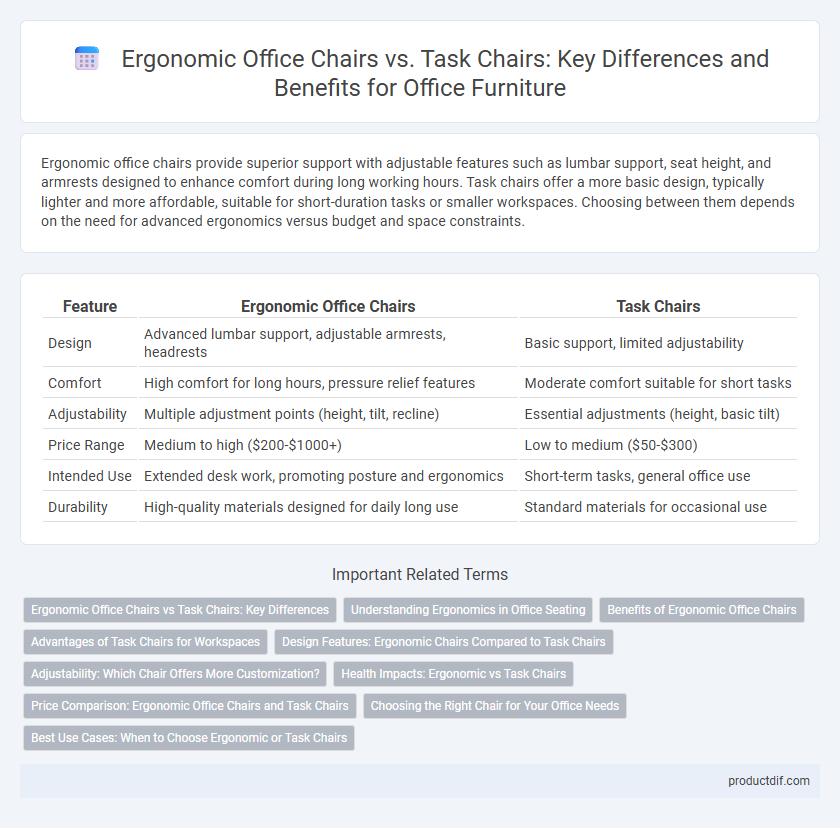Ergonomic office chairs provide superior support with adjustable features such as lumbar support, seat height, and armrests designed to enhance comfort during long working hours. Task chairs offer a more basic design, typically lighter and more affordable, suitable for short-duration tasks or smaller workspaces. Choosing between them depends on the need for advanced ergonomics versus budget and space constraints.
Table of Comparison
| Feature | Ergonomic Office Chairs | Task Chairs |
|---|---|---|
| Design | Advanced lumbar support, adjustable armrests, headrests | Basic support, limited adjustability |
| Comfort | High comfort for long hours, pressure relief features | Moderate comfort suitable for short tasks |
| Adjustability | Multiple adjustment points (height, tilt, recline) | Essential adjustments (height, basic tilt) |
| Price Range | Medium to high ($200-$1000+) | Low to medium ($50-$300) |
| Intended Use | Extended desk work, promoting posture and ergonomics | Short-term tasks, general office use |
| Durability | High-quality materials designed for daily long use | Standard materials for occasional use |
Ergonomic Office Chairs vs Task Chairs: Key Differences
Ergonomic office chairs prioritize advanced support features like adjustable lumbar support, seat depth, and multiple tilt mechanisms to promote long-term spinal health and comfort during extended use. Task chairs offer basic ergonomic functions with simpler adjustments, designed mainly for short-term tasks and flexibility in workspace mobility. Choosing between ergonomic office chairs and task chairs depends on user needs for durability, posture support, and frequency of use in professional environments.
Understanding Ergonomics in Office Seating
Ergonomic office chairs prioritize comprehensive support with adjustable features like lumbar support, seat height, and tilt mechanisms to enhance posture and reduce musculoskeletal strain during extended work hours. Task chairs offer more basic functionality, often designed for shorter durations with limited adjustments, focusing on mobility and convenience for quick tasks. Understanding ergonomics in office seating involves recognizing how tailored adjustments and cushioning in ergonomic chairs contribute to spinal alignment, improved circulation, and overall comfort compared to the simpler design of task chairs.
Benefits of Ergonomic Office Chairs
Ergonomic office chairs offer superior lumbar support, adjustable features, and enhanced cushioning that reduce back pain and improve posture during long hours of work. These chairs promote better blood circulation and minimize fatigue, increasing overall productivity and comfort. Task chairs, while functional, often lack the comprehensive adjustability and ergonomic design essential for extended use.
Advantages of Task Chairs for Workspaces
Task chairs offer enhanced adjustability and compact design, making them ideal for small or shared workspaces where flexibility is essential. Their lightweight structure allows for easy mobility, promoting dynamic work environments and quick transitions between tasks. Ergonomically designed task chairs support proper posture through adjustable features tailored to diverse body types, reducing fatigue during extended work hours.
Design Features: Ergonomic Chairs Compared to Task Chairs
Ergonomic office chairs feature adjustable lumbar support, headrests, and multiple tilt mechanisms designed to promote proper posture and reduce strain during extended use. Task chairs typically have a simpler design with basic height adjustment and limited recline options, prioritizing mobility and compactness for short-term tasks. The advanced design features of ergonomic chairs support long-term comfort and health, making them ideal for full-day office work environments.
Adjustability: Which Chair Offers More Customization?
Ergonomic office chairs typically offer greater adjustability, featuring multiple customizable settings such as seat height, lumbar support, armrest positions, and tilt tension for personalized comfort. Task chairs provide basic adjustments, often limited to seat height and simple tilt functions, making them less versatile for long-term use. Businesses prioritizing prolonged comfort and support should consider ergonomic chairs for their superior customization options.
Health Impacts: Ergonomic vs Task Chairs
Ergonomic office chairs are designed to support natural posture and reduce musculoskeletal strain by offering adjustable lumbar support, seat height, and armrests, promoting spinal health and reducing the risk of chronic back pain. Task chairs typically provide less comprehensive support, often lacking extensive adjustability, which can lead to increased fatigue, poor posture, and higher risk of repetitive strain injuries during prolonged use. Opting for an ergonomic chair significantly improves comfort and long-term health outcomes by encouraging dynamic sitting and proper alignment throughout the workday.
Price Comparison: Ergonomic Office Chairs and Task Chairs
Ergonomic office chairs typically range from $200 to $800, offering advanced lumbar support, adjustable armrests, and customizable height settings, while task chairs are generally priced between $50 and $200, focusing on basic functionality and minimal adjustability. The higher cost of ergonomic chairs reflects their enhanced design aimed at improving posture and reducing fatigue during extended use. Task chairs provide a budget-friendly option suitable for shorter durations but may lack the comprehensive comfort features found in ergonomic models.
Choosing the Right Chair for Your Office Needs
Ergonomic office chairs provide comprehensive support with adjustable features targeting posture, lumbar health, and prolonged comfort, making them ideal for full-day use. Task chairs offer a more compact design with basic adjustability, suited for shorter tasks and flexible office layouts. Selecting the right chair depends on the duration of use, workspace ergonomics, and specific support requirements to enhance productivity and reduce discomfort.
Best Use Cases: When to Choose Ergonomic or Task Chairs
Ergonomic office chairs are ideal for professionals who spend extended hours at their desks, as they provide advanced lumbar support, adjustable features, and enhanced comfort to reduce strain and improve posture. Task chairs suit environments requiring frequent movement and flexibility, offering lightweight design and basic adjustability optimal for short-duration tasks or dynamic workflows. Selecting between ergonomic and task chairs depends on the intensity of desk time and the necessity for ergonomic support versus mobility.
Ergonomic office chairs vs Task chairs Infographic

 productdif.com
productdif.com